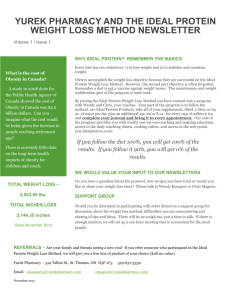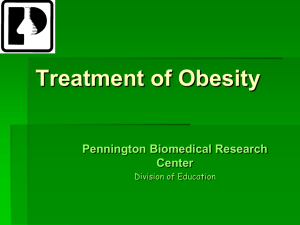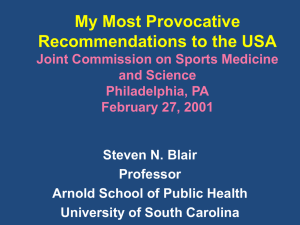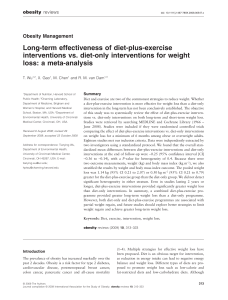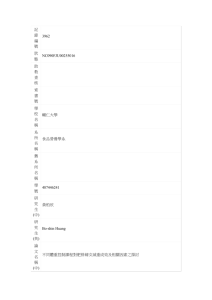Test Content Outline - American Board of Obesity Medicine
advertisement
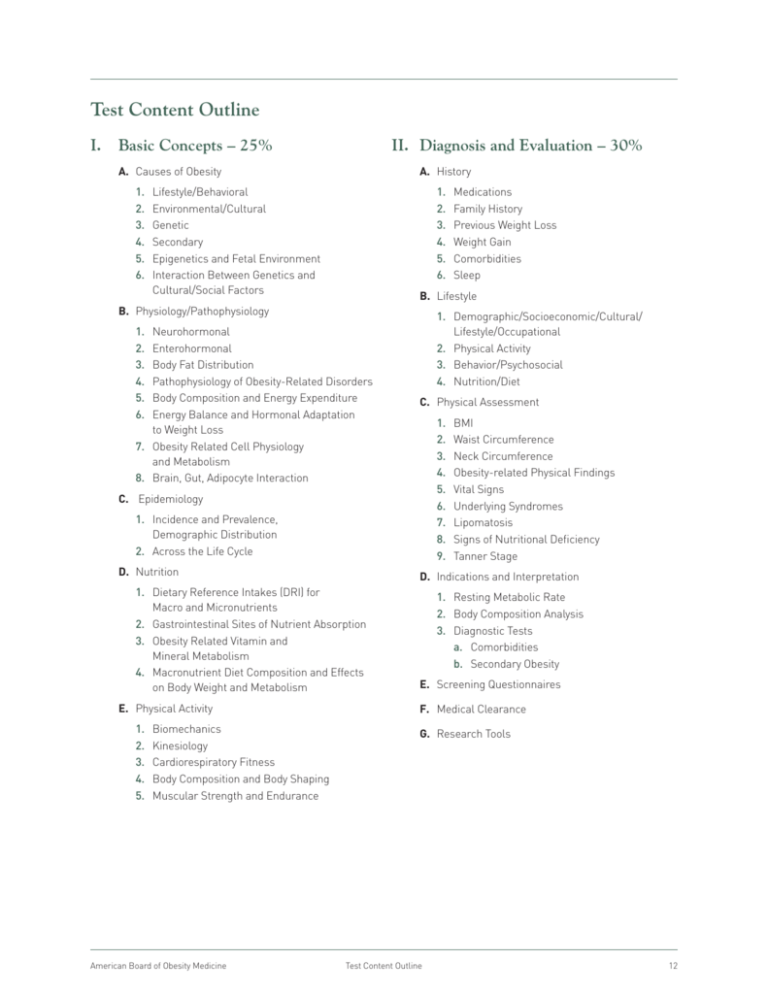
Test Content Outline I. Basic Concepts – 25% II. Diagnosis and Evaluation – 30% A. Causes of Obesity 1. 2. 3. 4. 5. 6. A. History Lifestyle/Behavioral Environmental/Cultural Genetic Secondary Epigenetics and Fetal Environment Interaction Between Genetics and Cultural/Social Factors 1. 2. 3. 4. 5. 6. B. Lifestyle B. Physiology/Pathophysiology 1. 2. 3. 4. 5. 6. 7. 8. Neurohormonal Enterohormonal Body Fat Distribution Pathophysiology of Obesity-Related Disorders Body Composition and Energy Expenditure Energy Balance and Hormonal Adaptation to Weight Loss Obesity Related Cell Physiology and Metabolism Brain, Gut, Adipocyte Interaction 1. Demographic/Socioeconomic/Cultural/ Lifestyle/Occupational 2. Physical Activity 3. Behavior/Psychosocial 4. Nutrition/Diet C. Physical Assessment 1. 2. 3. 4. 5. 6. 7. 8. 9. C. Epidemiology 1. Incidence and Prevalence, Demographic Distribution 2. Across the Life Cycle D. Nutrition 1. 2. 3. 4. 1. 2. 3. 4. 5. Biomechanics Kinesiology Cardiorespiratory Fitness Body Composition and Body Shaping Muscular Strength and Endurance American Board of Obesity Medicine BMI Waist Circumference Neck Circumference Obesity-related Physical Findings Vital Signs Underlying Syndromes Lipomatosis Signs of Nutritional Deficiency Tanner Stage D. Indications and Interpretation Dietary Reference Intakes (DRI) for Macro and Micronutrients Gastrointestinal Sites of Nutrient Absorption Obesity Related Vitamin and Mineral Metabolism Macronutrient Diet Composition and Effects on Body Weight and Metabolism E. Physical Activity Medications Family History Previous Weight Loss Weight Gain Comorbidities Sleep 1. Resting Metabolic Rate 2. Body Composition Analysis 3. Diagnostic Tests a. Comorbidities b. Secondary Obesity E. Screening Questionnaires F. Medical Clearance G. Research Tools Test Content Outline 12 III.Treatment – 40% 5. Post-operative Management a. Medical Inpatient b. Medical Outpatient c. Nutritional d. Psychological e. Adolescent Surgery A. Behavior 1. Techniques/Therapies 2. Self-Monitoring Tools B. Family Support and Participation I. Medical/Legal Consent Forms C. Individual, Group, Family Therapy J. Patient Education D. Diet 1. 2. 3. 4. 5. 6. K. Strategies Calorie and Micro/Macronutrient Very Low Calorie Diet Meal Replacement Available Resources Comorbid Conditions Pediatric Guidelines 1. 2. 3. 4. 5. 6. 7. 8. 9. E. Physical Activity 1. 2. 3. 4. 5. 6. FITTE Mechanisms of Action Prescription Tailoring Exercise Tools Methods to Reduce Sedentary Behaviors Partnerships with Community Based Programs IV. Practice Management – 5% A. Initial F. Pharmacotherapy, Pharmacology 1. Risks, Benefits, and Adverse Effects 2. Indications/Contraindications 3. Monitoring and Follow Up 4. Prescription Dose and Frequency 5. Drug-Drug, Drug-Nutrient, Drug-Herbal Interactions 6. Off Label Usage/OTC 7. Multi-drug/Combination Therapy 8. Interaction Between Obesity and Pharmacokinetics 9. Management of Drug-Induced Weight Gain 10.Local Regulations G. Alternative, Emerging, and Investigational Therapies 1. 2. 3. 4. 5. 6. Types, Risks, Benefits Indications and Contraindications Complications Pre-operative Assessment and Preparation a. Medical b. Nutritional c. Psychological American Board of Obesity Medicine Motivational Interviewing Recognition and Management of Weight Bias Stigma/Discrimination Patient/Family/Caregiver Engagement Culturally Tailored Communication Mental Health B. Office Procedures 1. 2. 3. 4. Policies and Protocols Obesity Management Guidelines and Recommendations Staff Training Techniques Physician Personal Health Behaviors C. Interdisciplinary Team 1. Role of Team 2. Communication and Collaboration 3. Advocacy H. Surgical Procedures 1. 2. 3. 4. Age-Related Treatment Appropriate Rate of Weight Loss and Weight Goal Risks Associated with Excessive Weight Loss Treatment of the Resistant Patient Weight Gain Prevention Strategies Management of Weight Plateau Strategies to Prevent Obesity anagement of Comorbid Conditions During Weight Loss Patient Management with Special Populations D. Other Test Content Outline 1. 2. 3. 4. 5. Inpatient and Outpatient Medical Complications Cost Effectiveness of Treatment Options Awareness of Societal Cost of Obesity Reimbursement and Coding Presentation of Success Rates 13




